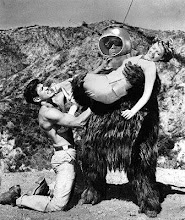Ready to rock your party guests' world, or just a tasty snack.
It's no secret that I enjoy many things from British culture, as is the case with many Americans, but I happen to be a Yank who absolutely loves British cooking. It's the epitome of “comfort food” and nothing exemplifies that to me more than the delicious simplicity of the humble sausage roll. If you think pigs in a blanket using cocktail weenies go over well as a party snack, these blow pigs in a blanket out of the water. All you need to make a big batch of these is the following:
2 pounds of thin breakfast link sausages (I prefer actual British-style chipolatas as obtained from Manhattan's Myers of Cheswick for their texture and seasoning, but Parks or Jones breakfast sausages will do just fine and they can be found at pretty much any local supermarket)
1 package of frozen puff pastry (I favor Pepperidge Farm puff pastry sheets)
NOTE: All food photos are from my kitchen (such as it is) and the batch of these I made tonight, in preparation to take a container of them home to my mother as a Christmas treat, so none of them were cribbed from the internet.
A tray of baked chipolatas, just out of the oven.
Next day, take your frozen puff pastry dough and allow it to reach room temperature. (The average package of puff pastry dough contains two large sheets divided into three sections, so you should have enough to wrap roughly two pounds of sausages.)
One sheet of room-temperature puff pastry.
Lay out the sheets of pastry on a cutting surface. Line up sausages on the pastry.
Eyeball however much may be needed to wrap individual sausages, cut pastry to size and wrap, making sure the seam is concealed underneath.
Once the wrapping in done, cut each sausage into three bite-sized pieces and place on a non-stick surface for baking.
Wrapped and sectioned.
Ready for the oven.
Pre-heat oven to 400 degrees. When the oven reaches proper heat, bake at the temperature and time-length stated on the pastry packing. (Pepperidge Farm states 15 minutes but I suggest 17, as that allows for a more crisp pastry effect.) When done, remove from oven, allow to cool, then serve.
Fresh out of the oven.
Two pounds of sausage links yields approximately 48 bite-sized pieces, by the way, and if allowed to cool and stored in a container in he fridge, they last for several days and should be slowly reheated at 300 degrees for 10-15 minutes, depending on your oven. Easy-peasy.
In a storage container, ready to be sealed and refrigerated.
The perfect teatime treat.



























